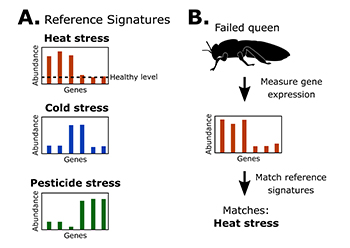
We need better tools to diagnose queen failure
The queen is special. So special, she is the only bee with the privilege of sporting a bright polka dot, marking her birth year. When we work through a hive, she is the only bee met with an exclamation — “Found her!” — upon spotting. And she is the only bee we would ever pay $40 or $50 for. She is the crux of the colony: If she fails unexpectedly, the whole colony is thrown into peril. And there are so many ways she could fail.
She may slowly succumb to the pesticides her workers bring in with their forage. She may get too cold when her package is installed in the early spring. She might get too hot during the trip from Hawaii to the mainland. Maybe she even suffered from the mite treatments we administered. Or she was wracked with nosemosis. Or she ran out of sperm. But when we open up a colony and see a sub-par brood pattern or frames of nothing but drones laid in worker cells, we are usually left guessing and eternally wondering why she failed.
I think we can do better than that. If we knew why our queens are failing, we might be able to improve our management practices to avoid future losses. “It’s like queen forensics,” my colleague, Bradford Vinson, aptly distilled after I told him about my new postdoctoral research project. My goal is to find molecular signatures that indicate if a queen was stressed out in the past, and if so, what from. A failing queen would normally be pinched and tossed, so why give her an autopsy instead?
This isn’t going to be your typical autopsy. Only two of the six causes of failure listed above, nosema infection and running out of sperm, can be determined with a simple dissection and microscope. The rest leave no visible traces. But the fact that we can’t see them doesn’t mean the traces aren’t there.
The cells in our bodies can respond to physiological stress by turning on genes that help mitigate it. For example, when cells heat up, they can be damaged by something called “oxidative stress” — that is, a build-up of highly reactive molecules (called free radicals) in the cells, which damage DNA and other important molecular machinery. But the cells have evolved to respond by turning on genes that neutralize those radicals, mitigating the damage they cause. Cold shock and pesticide stress cause their own physiological problems, leading to their own cellular responses. My hope is that I can find genes in the queen that are turned on under specific stressful conditions, and whose presence tell us something about what the queen has experienced in the past. We call these kinds of genes “biomarkers,” and by measuring the biomarkers in queens that have failed, we may be able to determine what caused her demise (Fig 1).
Heat shock is the first type of stress that I am investigating because I think it is an underappreciated problem. Queens are highly vulnerable to changes in temperature during shipment, when they are in small cages with few workers around to help thermoregulate. With rising frequencies, durations, and intensities of heatwaves, I wouldn’t be surprised if we begin to see heat shock occurring outside of shipments as well. Heat (in the range of 40 – 42°C, or 104 – 107.6°F) is bad for queens because it, and the oxidative stress it causes, kills their stored sperm. In the absence of enough workers to keep things cool, a mere two hours at 40°C is sufficient to reduce sperm viability by up to two-thirds.1
This doesn’t mean that a day or three of 40°C weather will damage the queen in a colony: The workers keep busy, collecting water and fanning to cool down the hive, much like what happens when we sweat. In particularly extreme conditions, workers even shield patches of brood comb (and potentially also the queen) with their bodies to insulate developing pupae.2 Given enough water, it is unlikely that a well-populated colony would ever suffer from acute heat stress, but swarms, mating nucs, packages, and bees going on foraging or mating flights could all still be vulnerable.
But there is a bigger picture to heat stress. Heat actually kills sperm, not only in honey bees, but also in other insects, fish, birds, and mammals (including humans). Some researchers have found that when ….


